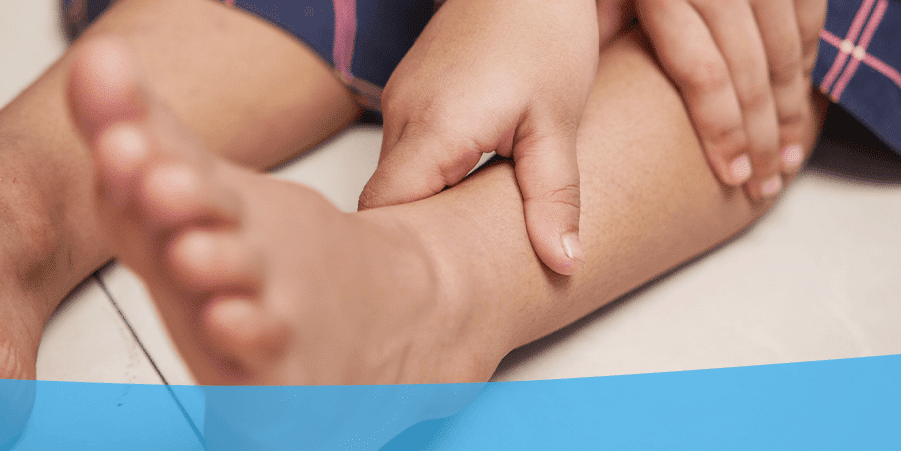While many people associate arthritis with getting older, it can happen at any age. When it occurs before the age of 16, it’s called juvenile arthritis (JA). JA can affect many joints in the body, including the foot, and this chronic condition can come with symptoms that make daily activities hard for children. Fortunately, early detection and treatment can make a big difference.
What Is Juvenile Arthritis?
Juvenile arthritis is also known as chronic childhood arthritis. It comes in several types, all of which stem from inflammation. Like other inflammatory diseases, JA causes the body to attack healthy cells and tissues. JA attacks the joints, leading them to become inflamed and stiffen up. If the disease progresses, the joints can suffer permanent damage and may even experience altered growth patterns.
JA can range in severity, and not all cases will progress to permanent damage. Although chronic childhood arthritis can affect all children, it’s more common in children and teens with anxiety, depression or a heart condition and among Black children. It’s also more common for kids who live in homes with food insecurity, low parental education and smoking in the home. Some types of JA are more common in boys or girls.
This disease often affects joints in the foot, causing pain and problems in this area. It can be difficult for children with arthritis in the foot or ankle to walk, stand and complete everyday tasks.
Types of Chronic Childhood Arthritis
Kids can have one of several types of juvenile arthritis. These types generally have chronic arthritic symptoms like joint pain, warmth, swelling and stiffness, but they differ in other ways.
Juvenile idiopathic arthritis (JIA) is the most common type of JA. It was previously called juvenile rheumatoid arthritis, but this name may have implied the disease was simply the child’s version of rheumatoid arthritis. The name eventually changed to reflect the differences between the two.
Idiopathic refers to the fact that the cause of JIA is unknown, although some researchers suspect genes that get activated by external factors, such as bacteria or viruses. This version of JA has six types:
- Oligoarticular: Oligoarticular refers to the number of joints affected. Oligoarticular JIA is the most common type, only affecting four or fewer joints. It’s present in about half of kids with juvenile idiopathic arthritis. Usually, the oligoarticular type affects larger joints, like the knee or ankle. Kids with this form may develop chronic eye inflammation called uveitis.
- Polyarthritis: Polyarthritis affects about 25% of kids with JA. It affects five or more joints and can include smaller ones, such as those in the feet.
- Psoriatic: If a child has arthritis along with psoriasis or a family member with psoriasis, they have this type of JA. Psoriasis occurs when skin cells multiply too quickly and cause scaly, inflamed patches of skin. Psoriatic JA can also include pitted fingernails and swollen fingers or toes, also called dactylitis.
- Enthesitis-related: In addition to inflamed joints, children with enthesitis-related arthritis also have enthesitis, or inflamed tendons and ligaments. Their joint pain might not have obvious swelling, and they could have back pain. Enthesitis commonly occurs in the heels and bottoms of the feet, while arthritis is common in the ankles and feet, among other places. This kind of JA happens more often in boys.
- Systemic: Systemic JA occurs throughout the body rather than in specific places. It typically starts with a fever and rash that appears intermittently over at least two weeks. The joints may not become inflamed until long after this period. Severe systemic JA can cause inflammation in organs, such as the spleen, liver, lymph nodes and the linings of the lungs and heart.
- Undifferentiated: When a child’s symptoms don’t fit into one of these types, or they fit more than one of them, they have undifferentiated arthritis.
Ankle and foot symptoms are more common in polyarthritis and enthesitis-related arthritis, but researchers found foot symptoms in 60%-90% of kids with JIA. Foot and ankle pain were associated with poorer quality-of-life scores and a higher impact on the child’s ability to perform daily activities. This pain can adversely affect a child’s emotional health, physical activity, school life and play behaviors. Minimizing inflammation and pain with proper treatment could be beneficial to many kids with pain in the ankle and foot from juvenile arthritis.
Other kinds of juvenile arthritis include:
- Juvenile myositis, which causes muscle weakness.
- Juvenile lupus, which usually appears as systemic lupus erythematosus (SLE).
- Juvenile scleroderma, in which the skin hardens and tightens.
- Vasculitis, which causes inflamed blood vessels and may lead to heart problems.
- Fibromyalgia, a chronic pain syndrome with muscle pain and stiffness, fatigue and disrupted sleep.
Signs and Symptoms
Juvenile arthritis symptoms can vary widely from case to case, but some common ones include:
- Joint pain
- Swelling
- Stiffness
- Fever
- Rash
- Fatigue
JA may also cause problems related to internal organs, such as bloating and diarrhea from the digestive tract or shortness of breath in the lungs. Problems with bone development might delay growth for some kids with JIA and cause osteoporosis, which makes the bones thinner and easier to break. These issues usually come from the inflammation itself or medications used in treatment.
A potentially serious complication of JA is uveitis, inflammation in the eye. It can cause pain, dryness, redness, vision problems and light sensitivity. If not treated, uveitis can lead to glaucoma, cataracts or blindness.
When juvenile arthritis symptoms affect the foot, kids might have pain and trouble walking. Swelling and chronic inflammation from JA symptoms could also lead to various foot symptoms like ingrown toenails, bunions and hammertoes.
Treatment and Outlook
A rheumatologist often diagnoses JIA, but sometimes a pediatrician will do it or a specialist for different areas of the body. During the appointment, the doctor will likely perform a physical exam and review the child’s symptoms, family history, lab results and imaging, such as X-rays or computed tomography (CT) tests.
If a child has JA, the doctor can start treatment, which usually consists of medication and lifestyle changes, including low-impact physical activity and healthy eating habits. While JA is not completely curable, treatment can help kids enter remission, where they stop exhibiting symptoms. Juvenile arthritis treatment also aims to slow or stop the disease’s progression, prevent long-term damage and relieve symptoms.
While some children permanently enter remission, many will still have arthritis into adulthood. Early treatment is crucial for preventing long-term problems.
Some medications that may help with JA include:
- Corticosteroids: Corticosteroids work quickly to reduce inflammation. Doctors typically only prescribe these for short-term use to avoid side effects.
- Disease-modifying antirheumatic drugs (DMARDs): DMARDs alter JA’s progression, suppressing the immune system to keep it from attacking joints. Doctors may use traditional DMARDs for a broader effect, or biologics, which target more specific chemicals or processes but work quickly.
- Analgesics: Analgesics are pain relievers, such as aspirin or nonsteroidal anti-inflammatory drugs (NSAIDs) like ibuprofen. While they can help relieve pain, they don’t prevent joint damage or change disease progression.
Physical therapy can help children build strength, flexibility and coordination and help with assistive devices such as splints or braces. Custom orthotics can also help with juvenile arthritis in the feet. In severe cases, a doctor might recommend a joint replacement for kids with joint damage or severe pain.
Relief for Juvenile Arthritis Foot Pain
If you or your loved one is showing symptoms of JA, make an appointment with a provider. When symptoms mainly appear in the foot or ankle, the diagnostic team at Foot & Ankle Surgical Associates can help with imaging tests and experienced doctors. We also offer several treatment methods for children with arthritis, such as physical therapy, custom orthotics and surgery. Many of our providers are great with kids and can help make the process as comfortable as possible.
Reach out today at 360-754-FEET (360-754-3338) or fill out our contact form to schedule an appointment.



